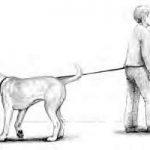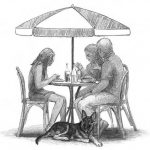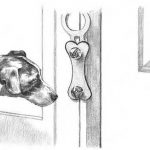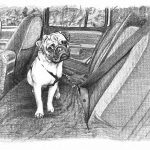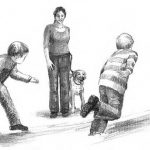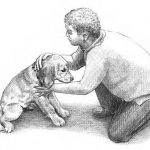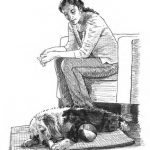In This Chapter
- Recognizing gotta-go potty behavior
- Scheduling time for your dog to go
- Training your dog to potty on command
- Crate-training your mixed breed
- Housetraining your indoor dog
- Preventing accidents
Everyone who gets a new dog must immediately begin working on the most important task: housetraining. Whether you got your dog at a shelter or from a breeder, whether she’s a Heinz 57 or a Labradoodle, the techniques are the same, and I fill you in on the basics in this chapter.
But before you can teach your dog when and where to relieve herself, you need to recognize when she’s telling you that she has go. In this chapter, I show you how to read your dog’s body language, recognize her warning signs, and reward her at the appropriate moments.
In this chapter, you discover how a crate can help you train your dog, whether she’ll have access to a yard or stay indoors. Speaking of indoor dogs, I let you know how you can train your dog to do her business in a designated place inside. I also cover creating a schedule so that your dog will know when she’ll have a chance to go. As you schedule your dog’s relief times, you’ll also teach your dog to potty on command, and in the specific location that you want.
Finally, a large part of housetraining is preventing accidents. I help you do exactly that, so your dog has more successes than failures and gets through housetraining with straight A’s.
When You Gotta Go: Looking for Your Dog’s Warning Signs
Dogs rarely just squat and potty out of the blue. Your dog will always do something specific prior to letting loose. As you hang out with your dog, look for sniffing, circling, whining, or sitting and staring as she wonders why you can’t understand that she really needs to go out now. Here’s some more of what to expect with each of these common warning signs:
– Sniffing: The sniffing dog is the toughest to detect, because dogs are always sniffing in their quest for something edible or fun to play with. Believe it or not, there will be a pattern. Your dog may sniff in a circle. Or she may sniff to detect a specific spot in the house where she had an accident recently. (Cleaning the entire smell off carpet or other flooring is nearly impossible, so it’s a good bet that your dog will aim for the same area when she has to go again.)
– Circling: Circling is an easier behavior to notice than sniffing is. Unless they’re arranging their sleeping place, dogs rarely move in circles. They prefer to go straight toward a person, other animal, or toy. The classic potty circles are usually small in circumference and are normally accompanied by sniffing. When your dog is getting ready to sleep, she won’t sniff while she circles, so if you see the two behaviors together, you know what’s coming!
– Whining: The whining dog is, for all intents and purposes, verbalizing her need to potty. A dog who whines when she has to go out is a really smart dog, because she realizes that humans respond faster to sound than to body language (like sniffing and circling). Your dog may sit and stare at you as she whines, or she may go to the door and whine. Either way, she’s telling you she needs to go potty. No matter how you look at it, a dog can’t make her wishes any clearer than she can by whining.
– Sitting and starting: If your dog silently sits and stares at you, she may eventually give up and go potty directly in front of you. In the beginning stages of housetraining your pup, this behavior isn’t necessarily a sign of disrespect. Your dog is merely defining herself. She tried to tell you, and you didn’t listen. Next time, if your dog sits and stares at you, get her outside.
Warning!
If your older dog (older than 6 months of age) has a good idea of where to do her business and she happens to urinate or defecate directly in front of you, this may be a sign of disrespect. Essentially, your dog is marking her territory directly in front of you, challenging your authority. If your dog is completely housetrained and she does this, she needs obedience training — pronto! (See Chapter Hup, Two, Three, Four: Good Manners and Basic Training for more on obedience training.)
Some dogs prefer to potty in private. If your dog falls into this category, she’ll try to do so by leaving the room or going behind furniture. Later, you’ll find out what your dog’s been up to, but by then it’s too late to do anything besides clean it up. If you’ve experienced this, keep closer tabs on her. When she leaves the room, follow her. If she heads for the same place as before, take her to her potty area immediately.
Scheduling Potty Breaks
Tip
The best way to teach your dog when and where to relieve herself is to be consistent with her relief times. A dog who knows when she’ll have access to the relief area will learn to contain herself until those allotted times. In fact, figuring out when your mixed breed has to go, and what she has to do when she goes, will help both of you. You’ll know what she needs to do and when. And she’ll know that she has the opportunity to do her business in the correct place and that she’ll be rewarded for doing so.
The schedule that’s right for you and your dog will depend not only on what your dog needs to do, but also on your daily routine. If you’re away from home most of the day, you may want to hire a dog walker or place your dog in a securely fenced area with fresh water and shelter — a place where she can have access to a potty zone.
Playtime and potty time: They go hand in handIf you have kids, doggie accidents are even more likely than they are in a home without kids. Accidents tend to happen more when the kids come home from school or the family is together on the weekend. Why? Because there is more commotion and the adults tend not to pay as much attention to whether the dog needs to go out. Also, the more active your dog, the more often she needs to potty. Remember: Playtime is a high activity time for your dog, so keep a closer eye on her and watch for those gotta-go signs. |
Regardless of your work hours, your mixed-breed dog can adapt to your schedule. You just have to give her some guidance along the way.
If you work away from home all day
Working for a living is a fact of life for most people, and if you’re among the many who work outside the home, your dog will have to adjust to your being away. You need to give her a realistic schedule for feeding and potty breaks. The younger the dog, the ore often you’ll need to schedule her relief times.
Here’s a sample schedule. Use this in devising your own schedule to fit your needs:
6 a.m.
- Relief time. After holding it all night, your dog will need to relieve herself. She should do her business fairly quickly, allowing you to teach her to potty on command (see the “Training your dog to potty on command” section, later in this chapter).
6:15 a.m.
7 a.m.
- Take your dog to her relief zone.
7:45 a.m.
- Before leaving for work, take your dog to her relief area again.
7:45 a.m.– 6 p.m.
- If your mixed-breed dog is new to your house-hold, she should be contained in a safe area — such as a crate, pen, or fenced yard — while you’re gone.
6 p.m.
- As soon as you return home, take your dog to her relief area.
6:15 p.m.
7 p.m.
8:30 p.m.
10 p.m.
- Just before going to bed, take your dog to her relief area.
Tip
If your dog is younger than 4 months of age, she should be taken to her relief area:
- Within 15 minutes after eating
- Directly after getting up from a nap
- During playtime
- After each training session
She should also be taken every hour to hour and a half. Waiting longer is setting her up for an accident.
If you work out of your house
You may be home, but you’re busy, without the ability to constantly tend to your dog. Although you can take her to her relief area more often, which is great if your mixed-breed dog is very young, you may not have time to do so every hour. Scheduling her relief times is just as important as it would be if you worked away from home.
Here’s a sample schedule to help you in setting up your own:
6 a.m.
- Take your dog to her relief zone as soon as you get up in the morning.
6:15 a.m.
7 a.m.
- Take your dog to her relief zone.
Throughout the day
- Try to take your dog to her relief area every two to three hours (every one to one and a half hours if she’s under 4 months old). Remember: If, at any time, you can’t keep a close eye on your dog, contain her as described in the preceding section.
5 p.m.
5:15 p.m.
- Take your dog to her relief zone.
Throughout the evening
- The more activity there is in the evening, the more often your dog needs to be taken to her relief area.
10 p.m.
- Take her to her relief zone one last time, just before bedtime.
If your schedule changes frequently
Changing the relief schedule for your dog will be as difficult as it is for you — maybe more so. You can go to the bathroom anytime you want, but your dog has to wait for you to take her.
Try to develop a potty schedule for your dog that’s as consistent as possible, even if your own schedule changes. You may want to get help from a friend, family member, or neighbor to be sure your dog can stick to her normal schedule.
Warning!
Dogs are creatures of habit — taking away or constantly changing something in a dog’s routine will create anxiety.
If you must be away for an extended period of time, make arrangements with someone to come and take your dog to her relief area every four hours.
Crate-Training to Prevent Accidents
If your dog is new to your household, if she’s young, or if she has behavioral issues, you’ll need to keep her in a safe area when you can’t be with her. Restricting her access to your entire house will not only prevent her from destroying your home but also keep her from getting hurt. Containment also teaches your dog to contain her need to potty, because a dog who remains still is less likely to have to relieve herself than one who is moving around a lot.
This “safe zone” is commonly a crate, but it can also be a fenced yard or a large pen. Regardless of where you contain your dog, make sure she has shelter from the weather and fresh water at all times.
Warning!
Shelter from the weather doesn’t just mean a roof. Some breeds (like Boxers, Greyhounds, and other breeds with short coats) are very sensitive to extreme temperatures; if your dog is a mix of these breeds, be sure to provide her with a temperature-controlled environment where she won’t overheat in the summer or get too cold in the winter.
Tip
If you have a fenced yard, install a doggie door to the basement or kitchen. Place an exercise pen just inside the door so that your dog can come inside to escape the weather but won’t have free access to your home.
How the crate works
Many people mistakenly believe that crates are cruel. But unless they’re abused by being forced into the crate or left there for long periods of time, most dogs don’t think so. Crates simulate dens, and dogs like dens because they feel safe inside. The feeling of something solid all around gives them a sense of security. If you introduce the crate to your dog positively, she’ll be happy to stay inside while sleeping or go inside whenever she wants a little privacy.
Because most dogs remain still or sleep while they’re in their crates, they’re less likely to have to relieve themselves. Crates also help teach control while indoors. The crate is a place where your dog can safely reside when you can’t watch her. Plus, few dogs will potty in their crates, especially if the crate is the right size (big enough for the dog, but not so big that she can potty at one end and sleep far away in the other).
Technical Stuff
Most wild dogs build dens as a safe place to sleep or whelp puppies. Instinctually, they never mess in their dens — they always leave the enclosure to do their business in the surrounding area, not only as a means of relief but also as a way to mark their territory.
Crating is a great way to help with housetraining. Let’s say you take your dog outside to potty, but she’s too distracted to relieve herself. After ten minutes, you bring her back inside, place her in her crate for 30 minutes, and try again. She’ll probably have to relieve herself after that half-hour is up. Then you can praise and reward her for going in the correct location instead of being punished for relieving herself in the house.
Tip
Crating expedites the housetraining process and prevents accidents, preventing constant negativity between you and your dog.
Remember
Never leave your dog locked in her crate for more than four to five hours at a time. She needs to stretch her legs, potty, and exercise. If you’re going to be gone longer than four or five hours, consider a safely fenced area or ask a friend to let her out several times while you’re away.
Introducing your dog to the crate
You want your dog to have positive associations with her crate, so the first rule to keep in mind is: Never use the crate as a place of punishment. Your dog should feel safe and happy in her crate; she should never be forced into it.
Begin by placing the crate in an area where you spend much of your time, such as the kitchen, family room, office, or bedroom. Put a comfortable doggie bed inside, along with a couple of toys and fresh water.
Tip
Use a small water bucket with a double-sided clip, and attach the bucket to the wall of the crate. This will prevent your dog from tipping over the water when she gets excited.
To introduce your dog to the crate, sit on the floor near the crate. Allow your dog to sniff the crate and go in if she wants. After your dog has become familiar with the crate, you can start training her to go into the crate on command. Here’s how:
1. When you have your dog’s attention, throw a treat or fun toy into the crate.
2. When your dog follows the reward into the crate, praise her and give her another reward.
3. Allow your dog to come out of the crate as she pleases.
4. Repeat Steps 1 through 3 several times until your dog is anticipating and going in the crate on her own.
5. Close the door of the crate while your dog is inside eating her treats.
6. Praise her and stick more treats through the crate so that your dog sees that she gets nice things when she stays inside.
7. After 2 minutes, open the door of the crate and let your dog come out if she chooses.
8. Repeat Steps 5 through 7, gradually increase the amount of time the crate door is closed while your dog is constantly being rewarded, until she relaxes comfortably for five minutes.
9. Repeat Steps 5 and 6, but instead of standing by the crate, give her a treat and briefly leave the room while your dog remains closed in her crate.
10. Peek around a corner and continually praise your dog.
11. Return to the room, give her a reward, and open the crate door.
12. Repeat Steps 9 through 11, gradually increasing the amount of time you’re gone, always returning with many rewards for your dog.
Tip
If your dog eats her treats quickly, offer a food-filled toy instead. A hollow rubber ball, bone, or dental scrubber works well. You can put treats inside or along the edges, so it takes longer for your dog to finish — keeping her occupied for a longer period of time.
When you’re home, leave the crate door open so that your dog can go in and out as she pleases.
As you’re gearing up to leave your dog in her crate for several hours at a time, you’ll need to start small in order to assure her she won’t be stuck in there forever. Begin with being away from home only ten minutes. Peek in the windows and check on her. If she’s happily playing with her toys or sleeping, return and reward her. If she’s showing anxiety, back up a bit and return to remaining home and peeking around the corner or to wherever she was comfortably relaxed.
Remember
Never be afraid to regress a little — doing so offers your dog a safe zone where she’s comfortable, and it prevents creating a dog with anxieties about being in the crate.
Teaching your dog to go in a specific area
Is your yard filled with doggie landmines? Does it have a polka dotted patina? Maybe you’d like to have your dog do her business in some out-of-the-way place so that nobody accidentally steps in it. You can teach your dog to potty in one specific area. It can be at the edge of a wooded area, a section of your yard, or somewhere along your walks that is more appropriate than in the middle of the sidewalk.
This won’t magically happen, however. You have to train your dog to do it through encouragement and rewards. You must also make the area attractive to your dog. The surface material needs to easily maintain a scent, be soft enough to scratch at, and be near enough to quickly reach.
Tip
Young puppies can’t hold it long enough to make it down the back stretch. You may want to begin their housetraining by allowing them to potty a little closer to home. After they have the idea of relieving themselves outdoors, you can gradually increase the distance from the house.
Dogs prefer to relieve themselves where they can smell the scent of other dogs. Some dogs also like to leave their own scent through scratching at the ground. As they scratch, they release their scent, covering the odor of the dog who previously visited. Taking your mixed breed to a location where she can catch a whiff of another dog will improve the chances that she’ll get her business done quickly.
You can make sure that your dog understands where she must go to relieve herself in a few ways. Be sure to accompany her there. Walk her on the leash to the location, then let her sniff and move around. Eventually, she’ll get the idea that this is where you want her to go. Remember: Reward her the moment she goes — praise and offer treats.
Eventually, you won’t need to take your dog to the location on-leash. You can run there, coaxing her to follow. As she relieves herself, praise and treat or throw a toy.
Remember
It may take some time to establish the relief spot. You’ll need to be patient and persistent. Also, watch your dog at all times. If she starts to show the signs of needing to potty in the wrong place, quickly guide her to the correct place. One accident in the wrong location will leave a scent, making it more difficult to guide her away from that area in the future.
Teaching your dog to get it done faster
Are you tired of waiting and waiting for your dog to do her business? Your dog may not care that the weather is uncomfortable — she’s more interested in the ground odors or the other dogs playing nearby. Why waste a perfectly good opportunity to say hello to someone?
This is where teaching your dog to relieve herself faster will be very beneficial. Moreover, it totally coincides with all the other things you’re doing to housetrain your mixed breed. After all, wouldn’t you rather she potty within a couple minutes instead of an hour?
You can speed things along in several ways:
– Make sure your dog really has to go when you take her out. If you stick to a specific schedule, you’ll know for sure what she has to do and when.
– Every time you take your dog to her relief zone and she potties, give her a reward the moment she finishes. Most dogs want their rewards so much that they’ll quickly do their business just so they can get that reward faster.
– If your dog won’t potty within five minutes, return her to her crate for a half-hour, and then try again. Repeat this until she does go. As soon as she relieves herself, give her a reward.
In less than a week, your dog will not only be letting you know when she has to relieve herself, she’ll also do so on command within a short period of time (see the following section).
Other Training Methods
If you live in a high-rise apartment building, you may decide to paper-train your dog so you’re not always having to wait for the elevator and hit the pavement before your dog does her business. If paper-training doesn’t appeal to you, you can also train your dog to use a litter pan, as cats do.
The procedures are basically the same as when teaching a dog to relieve herself outside:
- When not in a safely contained area, observe your dog at all times.
- Watch for those behavioral signs that it’s time to potty.
- Immediately take your dog to that spot (the paper or litter pan).
- Reward her when she does her business.
In the following sections, I go into some more detail on both of these methods.
Paper training
Paper is the usual surface cover of choice for indoor potty spots. A variety of products are available to create a specific potty zone for your little mixed-breed dog. Potty pads with plastic on one side and an absorbent surface on the other are readily available and very convenient, because they’re easy to dispose. Some potty pads are treated with a scent to entice your dog to use them.
Some potty pads also come with a plastic holder that you can use to hold the potty pads in place. Not only does this keep the pads spread out for easy use, but it also offers a surface different from the regular floor, so your dog sees a difference between the potty zone and the remainder of your house.
Home aloneIf you have an indoor dog, you can’t offer her a fenced yard to play in while you’re gone. But she still needs to be confined to a space smaller than your entire home. To set your little mixed-breed dog up for success, in both the housetraining and overall manners categories, confine her in an exercise pen that contains her bed, toys, water, and potty pad or litter box. This area will give her enough space to move around during the day, a place to rest, and her potty zone. |
Where you put the potty zone depends largely on the design of your home. If you have many different rooms, you may want to consider several potty zones. I recommend putting each zone on a hard floor, not carpeting. If your dog misses and some of her urine splashes onto the carpet, she may miss more often — on purpose, because the scent is there.
Using a litter pan
Dogs really love to dig, so you may want to use a litter pan instead of paper. The pan may be more enticing to your dog because she can potty in a more natural way.
Litter allows your dog to step onto a totally different surface from normal household flooring, making the potty zone very distinct from the rest of the house. Because pans tend to have high sides, your dog will be able to discern her relief area faster than a surface that might be close to the floor.
Another advantage to this method is that the litter will soak up “the urine, clumping it together for easy disposal (if you get the clumping kind of litter). It can also coat the feces for similar ease of disposal. Plus, the scent remains in the pan and doesn’t permeate other parts of your home. Your dog can scratch at the litter, leaving her scent as she chooses, making it even more attractive for use the next time.
Watching for Success
An ounce of prevention is worth a pound of cure. This adage is very meaningful in housetraining dogs. If you can prevent your dog from having accidents in the wrong place and guide her to the areas she can relieve herself, you’ll improve your relationship with your dog while forming lifelong good habits.
Nothing sours a relationship faster than constant frustration and punishment. More dogs end up at shelters and rescue organizations due to misbehavior than accidental breeding. The owners of these dogs never took the time to guide them toward correct behavior.
Remember
Your dog can’t read your mind.
Preventing housetraining accidents is one of the most important parts of the entire process. In the following sections, I help you keep accidents to a minimum.
Observing your dog
If you observe your dog closely, you’ll figure out exactly which visual cues your dog uses before she does her business. When you recognize the signs, you’ll know when she needs to go.
When your dog is loose in the house, you need to be watching her. Burying your head in a book or watching television will only serve to create the very situation you’re trying to prevent — accidents in the house.
You need to keep your eyes on your dog. Engage her in play or work with her on tricks. Keep her in the same room with you.
Tip
Have your dog wear a leash of at least 4 feet in length at all times. If she begins to leave the room, step on the leash and coax her to return. Praise her when she makes the correct decision. This is especially important for dogs who like to do their business in the next room or behind the couch.
Giving freedom only when she earns it
One of the worst things you can do with a new dog is to allow her total freedom of your home. Leaving your new dog alone, with free roam of your house, is a setup for disaster for both of you. Your dog will have an accident, and you’ll have to clean it up — plus, you may get frustrated with her, which does nothing for the bond that you’re trying to create.
Remember
Dogs need guidance. They thrive in a structured environment. Dogs love following the rules. It gives them a sense of pack structure; something very natural to their own instinctual behavior patterns.
Your dog has to earn everything she gets. Don’t allow your dog free roam of your home if she hasn’t yet proved she can be trusted.
Getting to the point where you can trust your dog all over your house, without being watched, may take anywhere from weeks to months to years. It’s a long, ongoing process, but being cautious and taking your time will reduce your own frustration and improve your dog’s understanding of what you want.
Tip
Never allow your dog any freedom within your home without first making sure she has done her business.
The initial stages of freedom go hand in hand with close observation. Don’t allow your dog to go where she wants without your being close behind. This way you can see any warning signs and whisk her to her relief area quickly. You can also prevent other types of problems such as chewing on the couch or eating something dangerous.
Tip
Begin allowing your dog to areas of the house other than her normal containment area by walking with her. Have her heeling at your side. Practice stays (see Chapter Hup, Two, Three, Four: Good Manners and Basic Training) in every room. Then allow her some free time to explore under your close supervision. This will teach her manners in all parts of the house.
As your dog learns to behave and contain herself in her one area, you can gradually allow her free access to other areas. For example, you begin with containing her in the kitchen. She has no accidents in the kitchen for several weeks. You can then offer her free access to the breakfast area along with the kitchen. As she proves herself worthy of more freedom, allow her more access to your house.
Tip
You can use baby gates to help cordon off specific rooms. Baby gates also keep your dog safely within her containment area without shutting her off from the rest of the house in a negative way, making her feel ostracized from her family pack (which, to a dog, is punishment).
Working on Some Advanced Housetraining Techniques
After your dog is housetrained (meaning, she knows where to go and she’s not having accidents in the house), you can take it up a notch and get her to go potty on command, as well as ring a bell to let you know when has to go out. Pretty nifty, huh?
Training your dog to potty on command
Wouldn’t it be great if you could teach your dog to come and tell you when she needs to relieve herself? And wouldn’t it be great if she did her business the minute she got into her potty zone — a location that you’d prefer she use? The good news is, all this can happen. You just have to be persistent and consistent with your dog, and she’ll aim to please you.
Begin by deciding on one specific word that you’ll use as a cue, such as hurry, potty, business, or empty. When you take your dog to her potty spot, say the word repeatedly until she actually relieves herself. When she is in the middle of relieving herself, say in a cheerful voice, “Good potty!”, or whatever word you’ve chosen to use. When she’s done, praise and give her a reward. Your dog will realize that her actions earn rewards, and dogs tend to repeat the behaviors that are rewarding. Most dogs pick up on the verbal cue very quickly. Usually within three days to a week.
Tip
You may want to choose a word that won’t embarrass you in public. I’ve always used the words hurry or go. They’re far less embarrassing than the word potty or the words for the bodily functions. Picture yourself standing in a crowded park with your dog. Would you rather say, “Pee-pee! Pee-pee!” or “Hurry! Hurry!”? I’m bettin’ on the latter.
Remember
When you follow one of the schedules discussed earlier in the chapter, you can easily use a specific word to cue your dog to potty, especially during the first morning relief times and whenever you’ve just let her out of her crate and taken her to her potty zone.
One of the best results of having a dog who potties on command is during travel. Stopping at a roadside table, rest area, or service station; taking your dog to a small grassy area; and giving the command is far easier and faster than having to walk your dog around for a long time, hoping that she’ll find just the right spot.
You rang? Getting your dog to ring a bell when she has to go
Earlier in the chapter, I cover some of the common warning signs that your dog may have to do her business. But you can bridge the language gap and teach your mixed breed a way of telling you that she has to go out, in a way you both understand. You can teach her to ring a bell to let you know she needs to relieve herself. (Be sure she knows how to potty on command before you train her to use a bell. She has to be able to go on command for the bell training to work.)
Tip
Several types of bells work well. Jingle bells and cow bells work nicely because their sounds are loud and clear.
Here’s how to train your dog to ring a bell when she has to go out:
1. Hang the bell on the knob of the door leading to your dog’s relief area.
2. Place a small piece of cheese, some peanut butter, or some canned dog food on the bell.
3. Coax your dog to the door and move the bell a little to get your dog’s attention.
4. Chances are, she already noticed you putting the food on the bell and she’s eagerly waiting to lick it off.
5. When your dog goes for the food, she’ll likely move the bell, making it ring.
6. As soon as the bell rings, open the door and take your dog to her relief area.
7. Cue her to relieve herself.
8. Praise and reward her the moment she potties.
Your mixed-breed dog should be ringing the bell on her own within a week or less. Just make sure that you can hear the sound when your dog is loose in the house, or she just might think that you still don’t understand her and she needs to do her business near the door, trying to clarify her needs.
by Miriam Fields-Babineau











